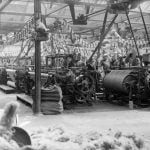The town rapidly expanded along Alyth Burn and to the south so that by the early 19thcentury there were shops down the full length of Toutie Street, the newly developed Commercial Street and the start of Mill street. Plans to develop the area to the south of the burn had been introduced by the Airlie Estate in 1786. The Market Square came to form the new centre of the town at the end of Airlie Street, the new approach from the south.
In 1883, as part of this town development, a new bridge was built over the burn joining the Market Square and Commercial Street. This replaced an old high-arched bridge probably built in the 17thcentury and cost £900, much of the money being raised by Isaac Peterkin, a shoemaker in the town.
Airlie Street was lined with shops and houses on both sides. There were two coaching inns and as the century progressed and methods of transport advanced, there came a railway station, a garage, and bus and taxi services. By the early 1900s Alyth was of sufficient importance to merit an entry in Burrows Guide No. 614 in which was written:
“..the modern town is up-to-date in its buildings, which, for the most part, do not exceed two storeys in height and are furnished with the latest improvements. Airlie Street, onto which the traveller steps in quitting the station, consists on the west side, of villas, churches and bank buildings, with grass and flower pots, shrubs and trees in front. On the east side are ranged business premises, where goods of all kinds can be purchased at prices as keenly cut as those of the cities.”
Between 1850 and 1950 over 150 shops and retailers are known to have operated in Alyth, selling everything from newspapers and advertising, food and provisions, homeware, drugs and medical supplies, clothes, fabric, boots and shoes, watches and clocks, jewellery, saddles, harnesses, furniture, motor cars and cycles, as well as services provided by printers, hotels, cafes and restaurants, banks and the post office.
Sources: A Braw Toon for Messages, Dave Hutchison

